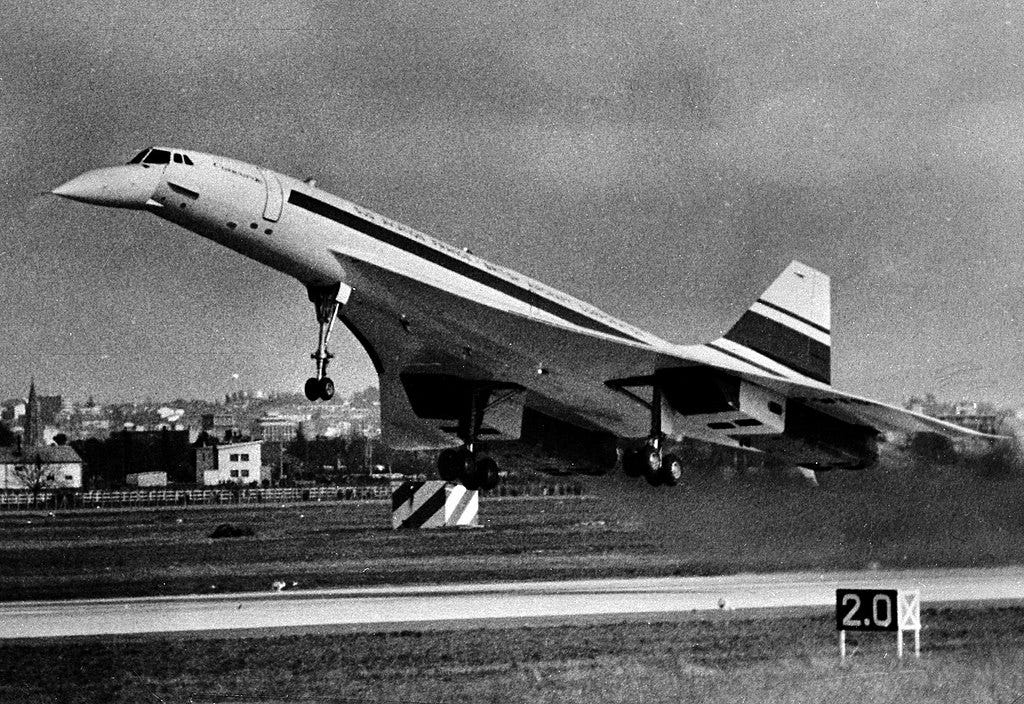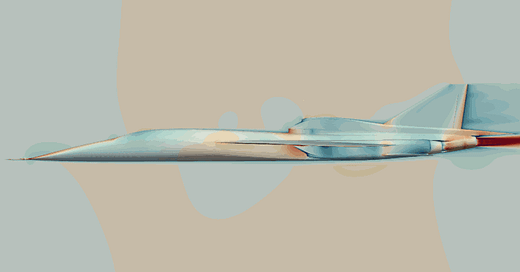Boom recently became the first American company to build and fly a civil jet faster than the speed of sound. This first test flight at supersonic speeds happened last week, on January 28.
The aircraft involved was the XB-1, an experimental aircraft.
What is Boom?
Boom Technology (also known as Boom Supersonic) is a VC-backed startup designing a 64-seat supersonic airliner called Overture. It’s got unique commercial airplane specifications — it carries fewer people faster at a higher altitude.
Founded in 2014, the firm participated in Y Combinator (S16), and has raised more than $150 million from private investors.
The company is headquartered in Colorado, conducted its recent flight tests at the Mojave Air and Space Port in California, and is building its production facility in North Carolina.
What exactly did Boom do?
Overture will eventually carry up to 80 passengers at cruise speed of Mach 1.7 (1.7x the speed of sound — which decreases as altitude increases). Right now, it’s mostly a design living on Boom’s computers.
Now, nobody has built a supersonic transport aircraft in nearly 50 years, and nobody has designed one since the 1960s. None of the prior aircraft were American-built or operated.
The folks over at Boom did what engineers do best — they built a smaller prototype to experimentally verify their design. Boom called it XB-1.

Designing and building an airplane is a significant accomplishment for a startup — they’re complex pieces of hardware.
Then the plane started flight tests.

Last week, Boom expanded the flight envelope of the aircraft by exceeding the speed of sound.
Why is Boom so exciting?
Scale
Scaling up supersonic transport operations has been a historically insurmountable challenge with prior supersonic transports.
The Soviet Tu-144 was the first civil aircraft to exceed both Mach 1 and Mach 2. Only 16 were ever produced. These aircraft were powered by turbofans made by Kuznetsov, or turbojets made by Kolesov. The aircraft’s commercial service life was short — only 8 years.

The Tu-144 was so complex that according to Wikipedia, the chief engineer of the aircraft from the Tupolev design bureau, and two senior civil servants, had to approve every flight. It conducted only 102 commercial flights, of which 55 carried passengers.

As far as I can tell, the key issues with scaling up operations of the Tu-144 were technical reliability and a bad passenger experience.
The Concorde was a contemporary, and it wasn’t much better in most respects. The technical specifications were roughly comparable — it could also cruise at Mach 2, and could carry up to 120 passengers (the Tu-144 carried up to 150) about 4,000 miles. Produced by an Anglo-French consortium, 20 aircraft were built. These aircraft were powered by turbojets made by a consortium between Rolls-Royce and Snecma.

In considering the size of the production run, it’s worth noting that the Concorde had more than 100 orders and 74 options as well — most of which were cancelled.
However, the Concorde did have a much longer commercial lifespan — 27 years. Most commercial flights were performed by British Airways and Air France. It also had a much nicer passenger experience — the whole plane was first class.
The key barriers to scaling up Concorde operations seem to have been more price point than anything else.
In both cases, supersonic civilian transport seems to have been a project that defined the manufacturing countries as engineering superpowers — comparable in this era of the Cold War to crewed spaceflight, ICBM deployment, and a few other accomplishments.
Boom is basically a bet that there’s a big enough market for supersonic transport at a lower price point than the Concorde had, several generations of aircraft after the last attempt concluded.
At this point, this seems like a pretty good idea. Boom already has more than 130 orders and pre-orders, with significant interest from American Airlines and United Airlines. Boom is also exploring high-speed transport for the military.
The size of the US market vs the Anglo-French market, and the difference in the size of potential government contract opportunities, gives me confidence that this is going to scale.
Engines
One of the things that I think is particularly interesting about Boom is that it has designed its own engines for Overture, called Symphony. Symphony is a turbofan engine.
This seems like an unusual decision in the context of the aviation industry. The skills required to design and manufacture an airplane engine are not the same skills needed to design and integrate an airplane.
The best evidence for this is to look at the most popular commercial aircraft and their engines:
Modern Boeing 737 airplanes use engines made by CFM International, a Franco-American consortium between Safran and GE Aerospace
Airbus A320 airplanes use engines made by CFM International; International Aero Engines, a joint venture between Pratt & Whitney, MTU Aero Engines, and Japanese Aero Engine corporation; and Pratt & Whitney
Moreover, most airlines don’t actually own the engines on their airplanes these days. It’s become quite common for them to lease the engines.
Vertically integrating the most technically complex subassembly of the aircraft, which neither Tupolev nor the Concorde consortium did, creates at least two additional potential revenue streams for the company:
engine maintenance
selling engines separately
It’s also quite significant that these engines will be produced domestically. Lots of countries build their own high-performance planes, but very few design their own engines for supersonic flight (most buy engines or produce them under license). The list that I know of is: the US, the UK, Russia, China, and France.
Adding another American high-performance engine vendor could unlock additional new architectures in the American aerospace industry for both commercial and national security aircraft.
Specifically in the context of national security, adding an engine vendor will start to turn around the trend of defense industrial base consolidation.
Furthermore, this sort of design capability expires as engineering experts move on to different projects or retire. Designing new engines like this maintains the knowledge in the workforce.
Boom does things that have never been done before
Doing things for the first time is always awesome.
This is how we drive civilization, and its constituent parts, forward.
There’s some narcissism of small differences here since an Anglo-French consortium and a Soviet design bureau accomplished what is in a technical sense the same thing about 50 years ago, but I’m enough of a patriot that I get excited when an American firm accomplishes something for the first time.
What am I still concerned about?
Boom has done a great job eliminating a lot of the risks in commercial supersonic transport. But there are two remaining risks in particular that I still don’t feel like I fully understand.
Luxury product
Supersonic transport trades travel time for money. The Concorde’s significant operational history shows that there’s at least some market for that along some routes.
But it’s clearly a luxury market. Bernard Arnault, the CEO of LVMH, has once made a great point about luxury products:
“Luxury goods are the only area in which it is possible to make luxury margins.”
The margins will be good, but the market size will be constrained.
Since the Concorde first flew, airplane technology has improved phenomenally. Travel by air is both cheaper and safer than it used to be. In 1977, it cost about $2,800 in 2023 dollars to fly the Concorde one way between London and Washington. By 1996, it cost about $12,500 in 2023 dollars. Today, a one way first class ticket on British Airways on the same route costs $12,873 in 2023 dollars. This is slightly higher than the 1996 Concorde cost, but on a per-hour basis, the flight today is much cheaper because it’s a longer flight.
However, communications technology has improved by an even greater order of magnitude. By 1977, the cost for a phone call abroad was not more than $15.75/minute in 2023 dollars ($3/minute in 1977 dollars). Today, I could speak with somebody in the UK for $0/minute by using Zoom or another video conferencing tool.
Concorde failed commercially in an era where transoceanic communication was more difficult, and more expensive, than it is today. The decline in the cost of communications since then should make Overture an even more intensively luxury product — and I’m curious as to how that’ll impact demand over the long run.
This is the biggest unanswered question I have about where Overture goes from here.
Customer Profit Potential
Concorde service was discontinued because it became unprofitable. The costs to operate the aircraft were greater than the revenue each flight generated.
One way to look at this is to say Concorde was too big if any seats were flying empty. Overture has a smaller passenger capacity, so this should be less common. At the same time, to the extent that demand is flexible, there will need to be more aircraft serving a route to have comparable capacity to what Concorde provided. From this perspective, at least along the same routes, this potential problem has been mitigated.
Another way to look at it is to dig into the costs. One of the largest costs of operating any airplane is fuel. Concorde’s engines had afterburners (“reheat” in the British terminology), which improve an airplane’s thrust by injecting fuel into the engine after the turbine. It allows the engine to produce more thrust, at the cost of lower fuel efficiency; this feature is mostly used on engines for high-performance military aircraft. Concorde needed this feature to take off, and to transition to supersonic flight, which made it very expensive to operate.
Boom is working on the problem primarily from the second perspective, and has two approaches in progress that seem likely to address this at least in part:
Symphony is designed to be capable of supercruise, of supersonic flight without an afterburner — in fact, it doesn’t have one
Symphony is designed to use 100% Sustainable Aviation Fuel — jet fuel from non-petroleum feedstocks
Sustainable Aviation Fuel currently commands a massive price premium over traditional aviation gas, but this is expected to change in the future





